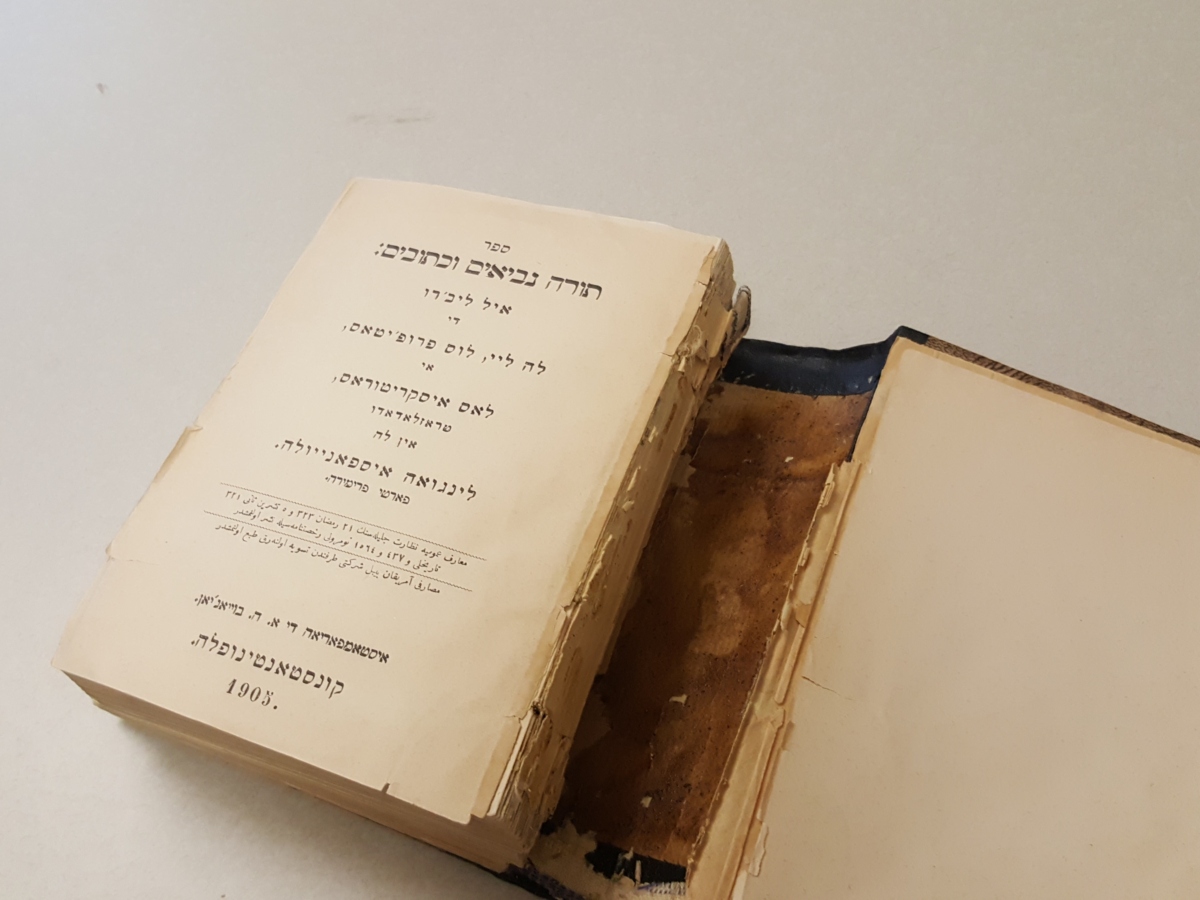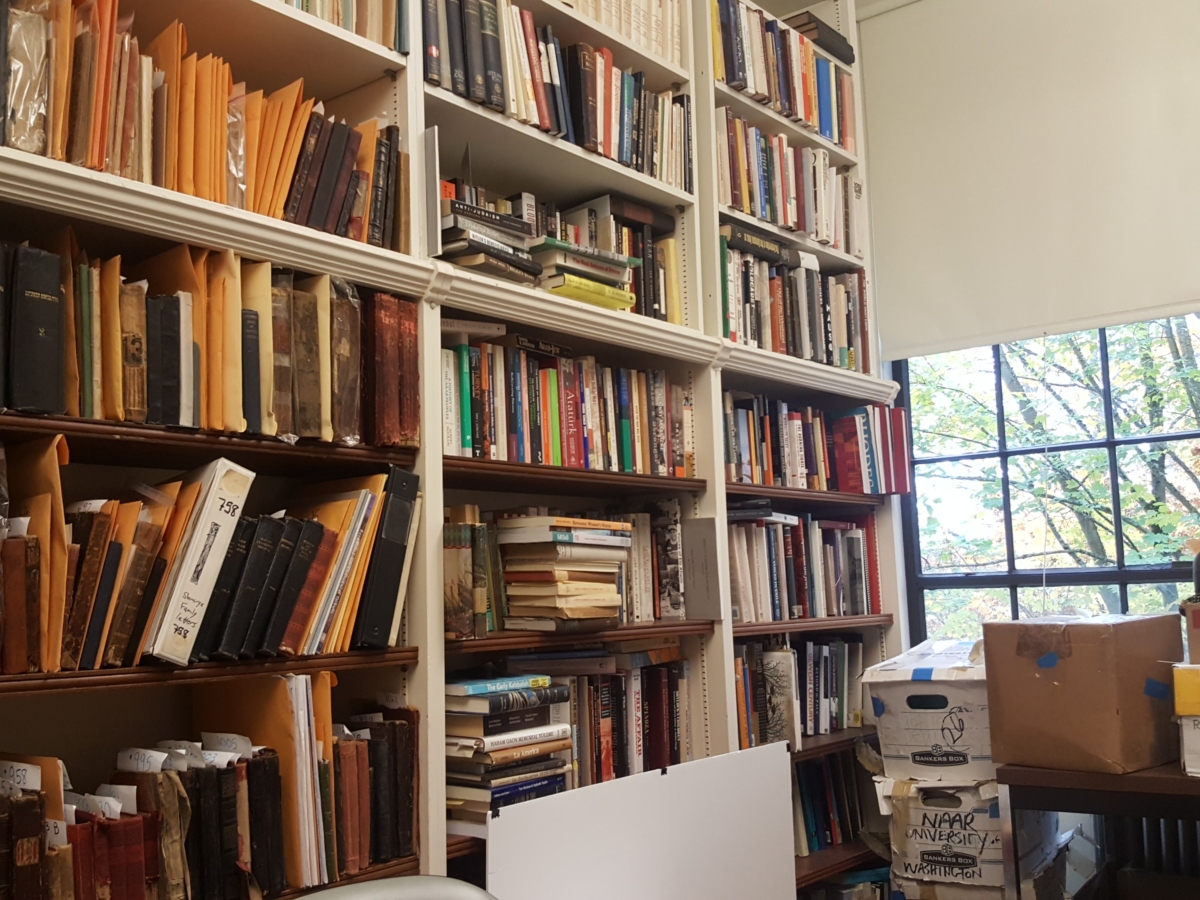
Devin Naar pulls a book off the shelf that comes from a generation long ago, printed in a century long gone in an Empire long since collapsed. Its lettering is in Hebrew, but to any Hebrew speakers, the words make no sense. But sound them out. Completely phonetically.
“La Ley, Los Prophitos, y Las Escritoras.”
That’s not Hebrew, although it is printed using the Hebrew alphabet. Phonetically, it’s Spanish — kind of — the way Shakespearean English sounds to students today. But translate it — The Law, The Prophets, and the Writings — and it becomes invariably, undoubtedly Jewish.
So what exactly is going on? What is this language that few have ever heard of and even fewer speak nowadays? And most importantly, why does are Naar’s bookcases filled with such texts?
To answer in order: it’s a combination of research and history. It’s a language called Ladino. And what’s happening in this small office on the third floor of Thomson Hall at the University of Washington is an effort unlike any other currently to preserve a language and a culture that has been fading for the past hundred years.
Naar, the chair of the UW Stroum Center for Jewish Studies’ Sephardic Studies Program, is one of the foremost scholars on Sephardic Judaism and the Ladino language in the country, and started his road with the simple realization of his difference.
“I grew up in an environment when I was very small in which I would visit the home of my grandfather and some of the older members of my family,” Naar said. “I would hear the Ladino language, I would hear stories about the old world in Greece and in Turkey, and I would smell the foods and the cuisine — really delicious, but unlike what my friends were eating.”
When most Americans think of Jews, they think of Ashkenazim — Jews whose roots come from Eastern Europe and the Pale of Settlement, whose ancestors spoke Yiddish, who came to America en masse in the late 1800s to escape the pogroms in Russia.
But Seattle’s Jewish history includes a significant chapter of Sephardic influence. When Jews were expelled from Spain in 1492, they spread across the world, taking Ladino with many going to the Ottoman Empire. When that fell following World War I, many of its Jews came to America.
As Naar reconnected with his family history, windows opened up for his future.
“People would be confused — and I was too — why was my grandfather was born in what is now Greece, but his older brothers were born in the same city but at that time it was part of the Ottoman Empire, but they spoke basically a Spanish language, but a Spanish language that they wrote in Hebrew letters, and yet they went to French schools,” Naar said. “That required some explanation, and so a little bit of reading here and there opened up this entire universe.”
After writing his dissertation at Stanford, Naar took an opening at the UW, presenting a special opportunity. Jews make up around 5 percent of the American population, and about 2 percent of American Jews are Sephardic. But Seattle has the largest proportion of Sephardic Jews anywhere outside of Israel. And since the 1910s, Turkish and Greek Sephardim have been intertwined with the city’s history.
“The first fish merchants at Pike Place Market were Ladino-speaking Sephardic Jews,” Naar said. “The family that has endowed the symphony hall, the Benaroyas, they are Sephardic Jews. Seattle [became] one of the few cities in America where Sephardic Jews … have made their imprint.”
But within the greater American Jewish community and the greater American population at large, Sephardic culture has faded. Barely anyone speaks Ladino anymore, making Naar and his linguistic abilities a valuable resource, especially in the Sephardic goldmine of Seattle.
In 2012, everything started to come together when some of the older members of the Sephardic community came to Naar, asking him to translate familial documents, books, and heirlooms.
“One of the first documents was brought to me by a gentleman in his 90s,” Naar said. “The only thing that he could read was the date and the place. It said ‘Seattle, 1942.’ So I start to read it to him, and starts to become very emotional. It turns out that it was his grandfather’s last will and testament. This guy, he’s an older guy, but he said that he had been waiting 70 years for me to come to Seattle to tell him what his grandfather had to say right before he passed away.”

Now, the Sephardic Treasures program has compiled more than 400 texts: Bibles, personal letters, essays on socialism, a translation of “Gulliver’s Travels.” The program takes in Ladino texts, digitizes them, and publishes them online for public viewing before giving back the original.
“There are other institutions, other universities that have smaller projects, translation projects, collection projects, but really we are in the leading position in that regard,” Naar said. “Our effort and our goal is to bring to public consciousness, both for the sake of students and scholars but also the broader public, and especially the descendants of this community who are no longer able to speak the language and have a sense of their own history or culture, to bring that out in the public and make part of the conversation about world cultures and histories, and to recognize the impact of those right here in Seattle.”
Naar and the program’s work will have a highlight come Dec. 5, at the Stroum Center’s annual Ladino Day. Speaking at the event will be Francois Azar, a French Sephardic author who compiled a collection of Sephardic folktales, both in Ladino and English, as well as Las Ladineros, a Seattle group dedicated to preserving the culture by discussions and readings.
“Unfortunately, we are the last generation of people who will ever really speak Ladino or understand Ladino,” said Victor Amira, one of Las Ladineros along with his wife Regina.
According to Naar, the program serves multiple groups. On one hand, it allows the newer generation of Sephardic Jews to reconnect with the culture of their grandparents that had faded due to assimilation. On the other, it can educate the greater American population of a minority group within a minority group that many have never heard of.
“A focus on the Sephardic experience will help us bust some myths and expand our understandings of the possibilities of what it means to be Jewish,” Naar said.
And in the current culture in America, preserving a dying language can have ramifications far beyond its few speakers.
“I think that’s what gives it a lot of power and a lot of resonance for us,” Naar said. “Today in a world today in which there is a lot of talk about building walls, this is a language that I see as having built bridges and potentially has the possibility of doing so again.”

